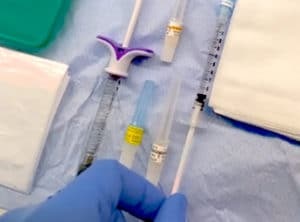Cannula Use Makes Vascular Occlusion Less Likely

The debate as to whether a needle or cannula is best for administering soft tissue filler may have just swung in the newcomer’s favour. An American study has found that using a cannula for fillers makes vascular occlusion (VO) less likely.
Published 30 December 2020 in JAMA Dermatology, the investigation sought to answer the question “When injecting fillers, what is the risk of vascular occlusion with needles vs cannulas?”
Low risk of vascular occlusion from fillers
The potential for vascular occlusions from fillers is of concern to many aesthetics practitioners, especially early on in their careers. This is understandable given, despite the likelihood of a VO occurring being low, they can have serious consequences.

This retrospective cohort study comprised 370 participating dermatologists, with a mean average of 22.3 years in practice and reported 1.7 million syringes injected. FDA approved filler was used throughout.
It found the risk of vascular occlusion from fillers to actually be “exceedingly low” (never in excess of 1 per 5000 syringes injected) when administered by board-certified dermatologists with either needles or cannulas.
Microcannula use less likely to cause vascular occlusion
The investigation article states the “primary outcome measure was intravascular occlusion. Occlusion events were graded by severity (no sequelae, scar, and ocular injury or blindness).”
At least one occlusion was reported by 106 (28.6%) of the 370 participants.
Researchers found the rate of intravascular occlusion to be 1 occlusion in 6,410 per 1-mL syringe for fillers administered via needle and 1 in 40, 882 per 1-mL syringe where a microcannula was used.
They concluded that:
- filler injections where a cannula was used were 77.1% less likely to cause unwanted vascular occlusion compared to those administered via a needle
- injectors with more than 5 years of experience with fillers were 70.7% less likely to cause a VO than less experienced practitioners
- the odds of occlusion decreased by 1% for each additional injection performed per week
- there were no long-term sequelae in 85% of occlusions
- “nasolabial folds and lips were most likely to be occluded, with mean severity level of occlusions highest at the glabella.”
Whilst clearly this shows that cannulas are associated with lower VO risk, further investigation is required.
As per the study authors: “Further research, including longitudinal prospective studies, are required to validate the findings obtained, including the degree of difference. Additionally, future studies may compare injectors with similar levels of experience and injection volumes but different number of occlusions to identify any technique differences that may be protective against occlusion. But based on the data analysed, it appears that both types of instruments are safe…”
Choosing between a needle and a cannula
The study authors note, “When it is feasible and appropriate based on patient characteristics, anatomic location and other clinical factors, dermatologists may consider using cannulas for filler injection to further minimise occlusion risk.”
This doesn’t mean all injectors should now switch to using a cannula though. Harley Academy founder and CEO, Dr Tristan Mehta advises using a needle when first starting out with fillers:
“When you first start practicing in aesthetics, you need to work on perfecting your technique and confidence. A needle is easier to work with and is more precise to begin injecting with. Once you are confident in your technique with a needle, then look to moving to a cannula where appropriate.
They can be tricky to get the hang of at first, but the more you use a cannula, the easier it will become…” Continues below.
“The more experience you have as an injector, the better you will be able to intuit the optimal solution for each situation. This innate understanding of your craft will develop over time, as your experience as an aesthetics specialist grows.
The key thing to keep at the forefront of your mind is your patient. Essentially, your practice should be led by what’s best for each patient – their safety and comfort. This will allow you to make the best decision and prevent vascular occlusions from occurring.”
This advice is echoed in the investigation conclusion which states, “Occlusion risk per syringe appeared decreased after the first few years of clinical practice and was also lower among those who more frequently inject fillers. Whether a needle or cannula is most appropriate for injection may depend on patient factors, anatomic site and the type of defect being treated.”
Harley students receive hands-on, one-to-one training in safe and effective injectables from experienced aesthetics specialists throughout their Level 7 Diploma training.
For students or medical professionals already practising in aesthetics who wish to give themselves a boost with more one-on-one time, 1:1 training sessions with a mentor are available separately. Obviously this clinical education can only take place when lockdown restrictions are no longer applicable.
This personal attention can be extremely useful for injectors wanting to get more experience and improve their techniques through up-close guidance and expert feedback.
As these study findings show, there’s no substitute for experience – which is a great reason to get started straight away!
All information correct at the time of publication. Article last fact-checked: 20 January 2023
Download our full prospectus
Browse all our injectables, dermal fillers and cosmetic dermatology courses in one document
By submitting this form, you agree to receive marketing about our products, events, promotions and exclusive content. Consent is not a condition of purchase, and no purchase is necessary. Message frequency varies. View our Privacy Policy and Terms & Conditions
Attend our FREE open evening
If you're not sure which course is right for you, let us help
Join us online or in-person at our free open evening to learn more
Our Partners













STAY INFORMED
Sign up to receive industry news, careers advice, special offers and information on Harley Academy courses and services

